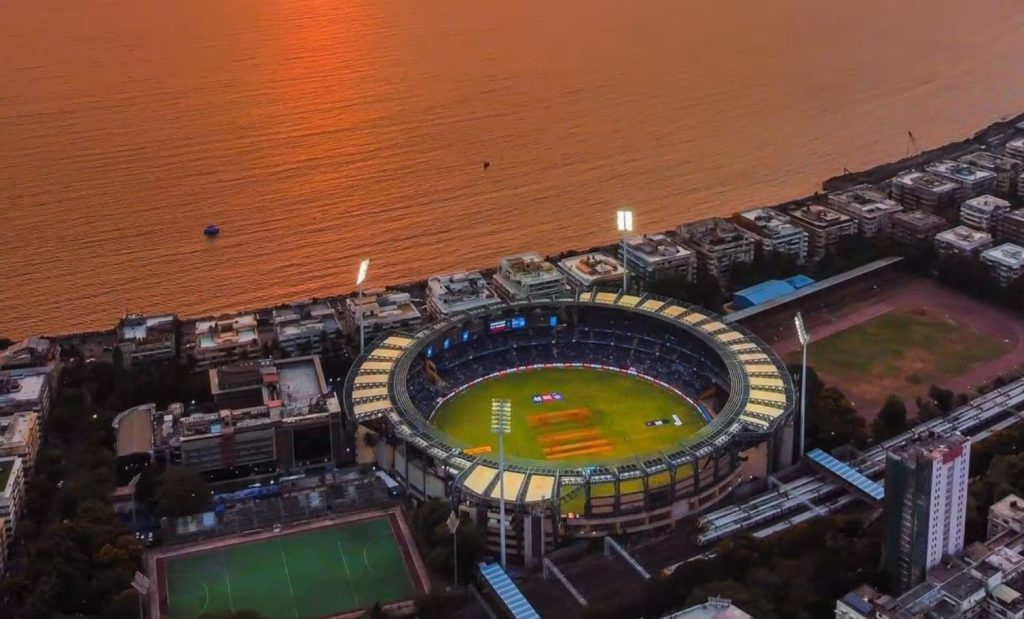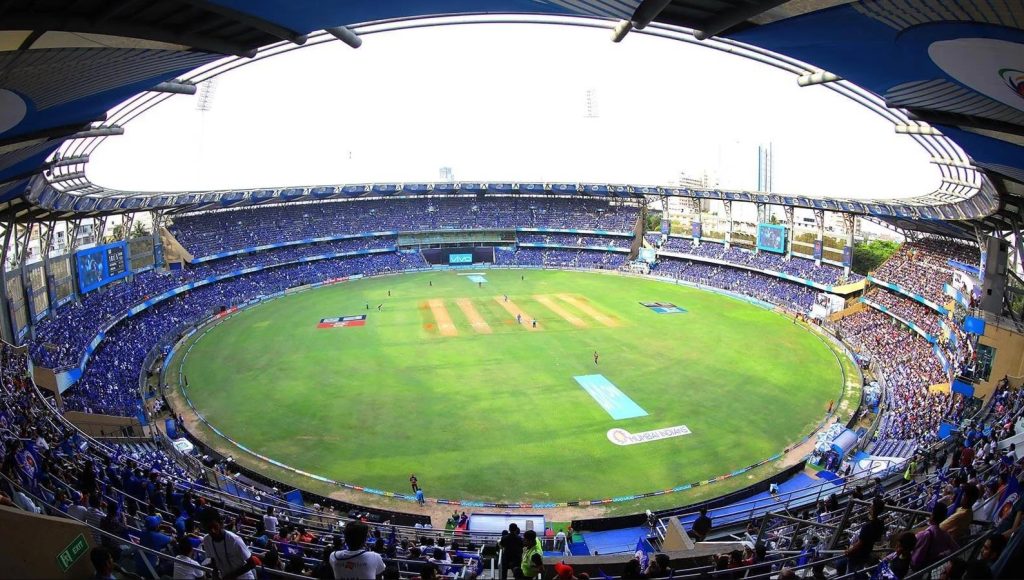Wankhede Stadium: Wankhede Stadium, situated in the heart of Mumbai, is one of the most iconic and well-known cricket grounds in India. Known for its vibrant atmosphere, passionate crowds, and significant cricketing history, it has hosted some of the most memorable matches in both international and domestic cricket.
The ground size of Wankhede Stadium plays a crucial role in shaping the dynamics of the game, influencing both the strategy of teams and the expectations of the spectators. This article will explore the ground size of Wankhede Stadium, its impact on the game, and the various features that make it a unique venue.

History and Significance of Wankhede Stadium
Wankhede Stadium was inaugurated in 1974 and has since become a key venue for both domestic and international cricket in India. Located in South Mumbai, the stadium is known for its proximity to the Arabian Sea, offering a scenic backdrop to many cricketing events. Over the years, it has been renovated and upgraded several times to meet international standards, making it one of the most modern cricketing venues in the country.
The stadium has hosted several landmark matches, including the 1987 Cricket World Cup, the 2011 ICC Cricket World Cup Final, and numerous Indian Premier League (IPL) games. It is also the home ground for the Mumbai Indians IPL franchise, one of the most successful teams in the tournament’s history.
Wankhede Stadium’s design and ground size are important factors that influence the nature of the matches played here. Known for being a high-scoring venue, it presents unique challenges for both bowlers and batsmen due to its dimensions and playing surface.

Wankhede Stadium Ground Size and Dimensions
The dimensions of a cricket ground play a significant role in how the game unfolds. A larger ground tends to favor bowlers, providing them with more space to work with, while smaller grounds, like Wankhede, tend to favor batsmen by making boundaries easier to clear. Let’s dive into the specifics of Wankhede Stadium’s size and layout.
1. Boundary Lengths
Wankhede Stadium features relatively short boundaries compared to many other international grounds. The dimensions of the playing field are important in determining the balance between bat and ball. Shorter boundaries create more opportunities for batsmen to score quickly, especially in formats like T20 and One Day Internationals (ODIs).
The boundary lengths at Wankhede Stadium are as follows:
| Boundary Type | Length (in meters) |
|---|---|
| Straight Boundary | 65 meters |
| Square Boundary (both sides) | 60 meters |
| Leg Side Boundary | 60 meters |
| Off Side Boundary | 60 meters |
As seen from the table, the straight boundaries are around 65 meters, while the square boundaries on both sides are slightly shorter, at approximately 60 meters. This makes Wankhede one of the smaller grounds in terms of dimensions, particularly when compared to stadiums like the Melbourne Cricket Ground or Lord’s, which have much larger outfields.

These shorter boundaries encourage aggressive batting, and as a result, Wankhede Stadium often witnesses high-scoring encounters, especially during IPL matches, where big hits are common. The shorter square boundaries, in particular, allow batsmen to hit to the leg side more easily, creating thrilling moments for fans.
2. Pitch Characteristics
In addition to boundary dimensions, the pitch characteristics at Wankhede Stadium also play a crucial role in the overall game dynamics. The pitch at Wankhede is known to be batting-friendly, with consistent bounce and good pace, making it conducive to stroke-making. This, combined with the shorter boundary lengths, creates an environment where high run-scoring is almost a guarantee.
Typically, the pitch at Wankhede is hard and flat, offering little assistance to the bowlers in the early stages of the match. Fast bowlers might find some bounce, but there isn’t much movement off the pitch, particularly for swing bowlers. As the game progresses, the pitch may slow down slightly, providing some assistance to spinners in the middle overs. However, even in the latter stages, the pitch generally remains good for batting, and scores tend to be high.

The fast outfield, combined with the shorter boundaries, further emphasizes the batting-friendly nature of the ground. Fielding plays an essential role here, as well, with quick outfielding and good boundary coverage being critical for limiting runs.
3. Seating and Spectator Areas
Wankhede Stadium has a seating capacity of approximately 33,000, which, while smaller than some of the larger international stadiums, creates a more intimate and energetic atmosphere for spectators. The stands are positioned relatively close to the playing field, making the fans feel directly connected to the game.
The ground layout includes:
- East and West Stands: These stands are located on opposite sides of the stadium and offer a great view of the match. They are the most popular among spectators and have the largest number of seating.
- North and South Stands: Located behind the wickets, these stands are positioned at the far ends of the stadium but still offer a great view of the action. These stands cater to both general public and premium ticket holders.
- Corporate Boxes and VIP Areas: Located above the stands, the corporate boxes provide a more exclusive experience with views of the ground from a higher vantage point.
The relatively compact size of the stadium enhances the atmosphere, as the crowd is close to the action. This often leads to an electric environment, especially during crucial moments in a match.

4. Impact on Various Formats
Wankhede Stadium’s ground size plays a particularly significant role in T20 cricket, such as the IPL. The short boundaries encourage aggressive batting, and games here often feature high scores. Teams with powerful hitters tend to thrive in such conditions, making it an ideal venue for teams like Mumbai Indians, who regularly take advantage of the small boundaries.
In One Day Internationals (ODIs), the dimensions of the ground allow for big-hitting from batsmen, but the fast outfield can often result in quick boundaries, making it a challenging ground for bowlers. Spinners do get some assistance, but fast bowlers, especially those who can extract bounce, often struggle to contain the runs.
For Test cricket, Wankhede’s shorter boundaries present different challenges. The nature of the pitch, combined with the small ground size, often leads to more aggressive declarations and high-scoring games. However, the conditions can be challenging for bowlers, especially in the shorter formats, where fast bowlers may find it difficult to contain runs.

5. The Spectator Experience
One of the most defining features of Wankhede Stadium is its atmosphere. The stadium’s compact size ensures that fans are close to the action, amplifying the excitement of every moment. Whether it’s a six sailing over the boundary or a crucial wicket falling, the crowd’s reaction is felt by everyone, making the experience truly unforgettable.
Wankhede Stadium is also famous for its enthusiastic crowd, often referred to as some of the most passionate cricket fans in the country. The proximity of the stands to the playing field adds to the energy, as fans are very much a part of the action. This creates a unique and electric environment, making Wankhede one of the most sought-after venues for international and domestic cricket.
Wankhede Stadium’s ground size plays a significant role in shaping the nature of the game. With short boundaries and a flat pitch, it offers a batting-friendly environment, encouraging big-hitting and high-scoring matches. The dimensions of the ground make it a particularly exciting venue for T20 cricket, while also posing challenges for bowlers who need to adapt to the conditions. The stadium’s compact layout and passionate crowd create a unique atmosphere, making it one of the most iconic cricket grounds in India.

As one of Mumbai’s proudest cricketing landmarks, Wankhede Stadium continues to be a key venue for memorable matches and thrilling moments in the world of cricket. Its combination of size, pitch conditions, and spectator experience makes it a venue that stands out in the global cricketing landscape.
Also Read: Exploring the Layout of Chinnaswamy Stadium: A Closer Look at Its Design and Features













